Analyzing Knowledge Management's Role in Marketing Innovation Project
VerifiedAdded on 2022/09/02
|9
|1639
|31
Project
AI Summary
This project investigates the role of knowledge management in driving marketing innovation. It begins by analyzing the business decision or problem, focusing on how knowledge management impacts marketing innovation and facilitates management aspects. The research objectives aim to determine this impact and the research question asks how knowledge management contributes to the development of marketing innovation. The project reviews relevant literature, discusses research design options, and selects a descriptive research design. It identifies key variables like knowledge management and marketing innovation, and outlines sampling methods, including probability and non-probability techniques. The project also includes a timeline for activities, addresses ethical considerations, and provides a comprehensive list of references.
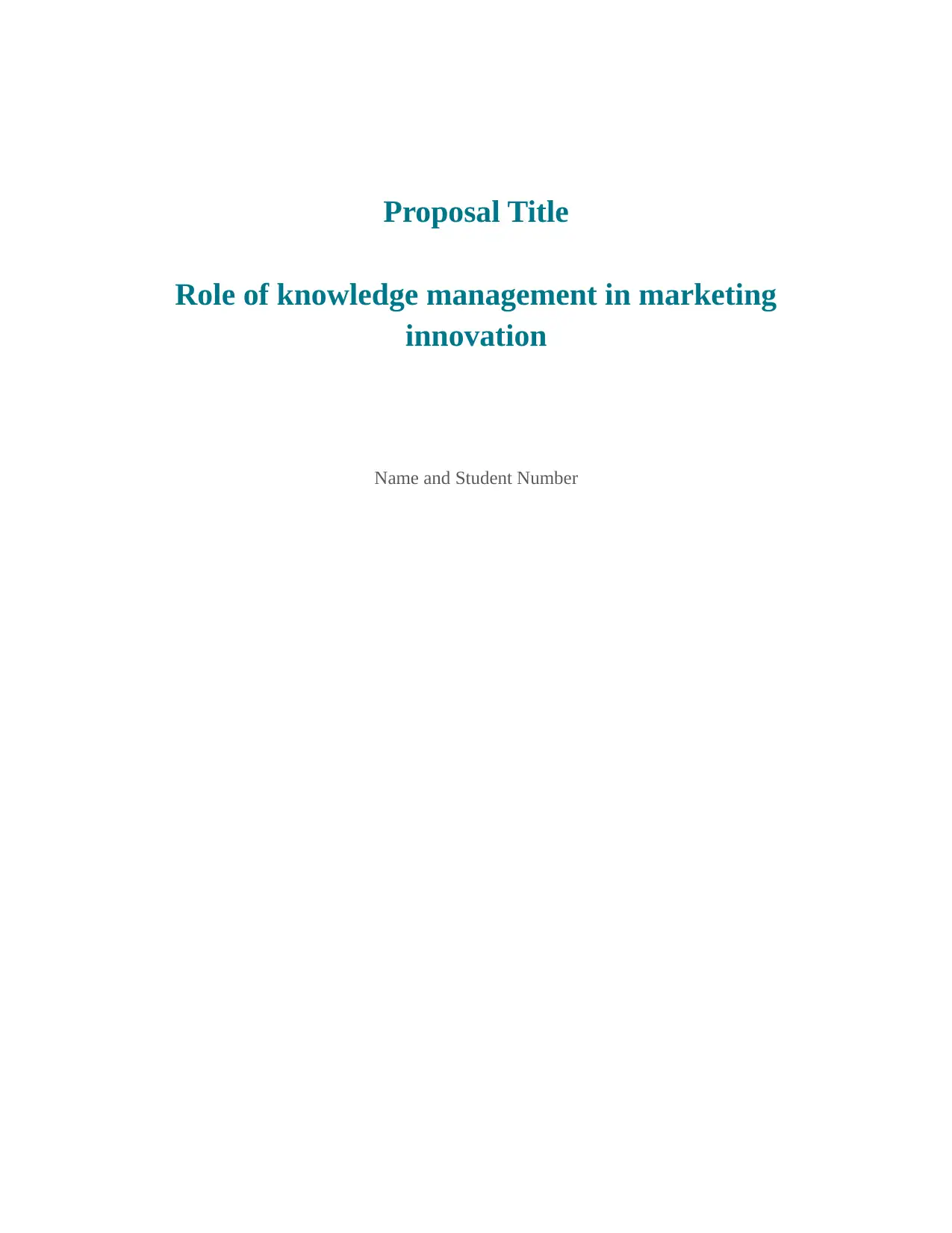
Proposal Title
Role of knowledge management in marketing
innovation
Name and Student Number
Role of knowledge management in marketing
innovation
Name and Student Number
Paraphrase This Document
Need a fresh take? Get an instant paraphrase of this document with our AI Paraphraser
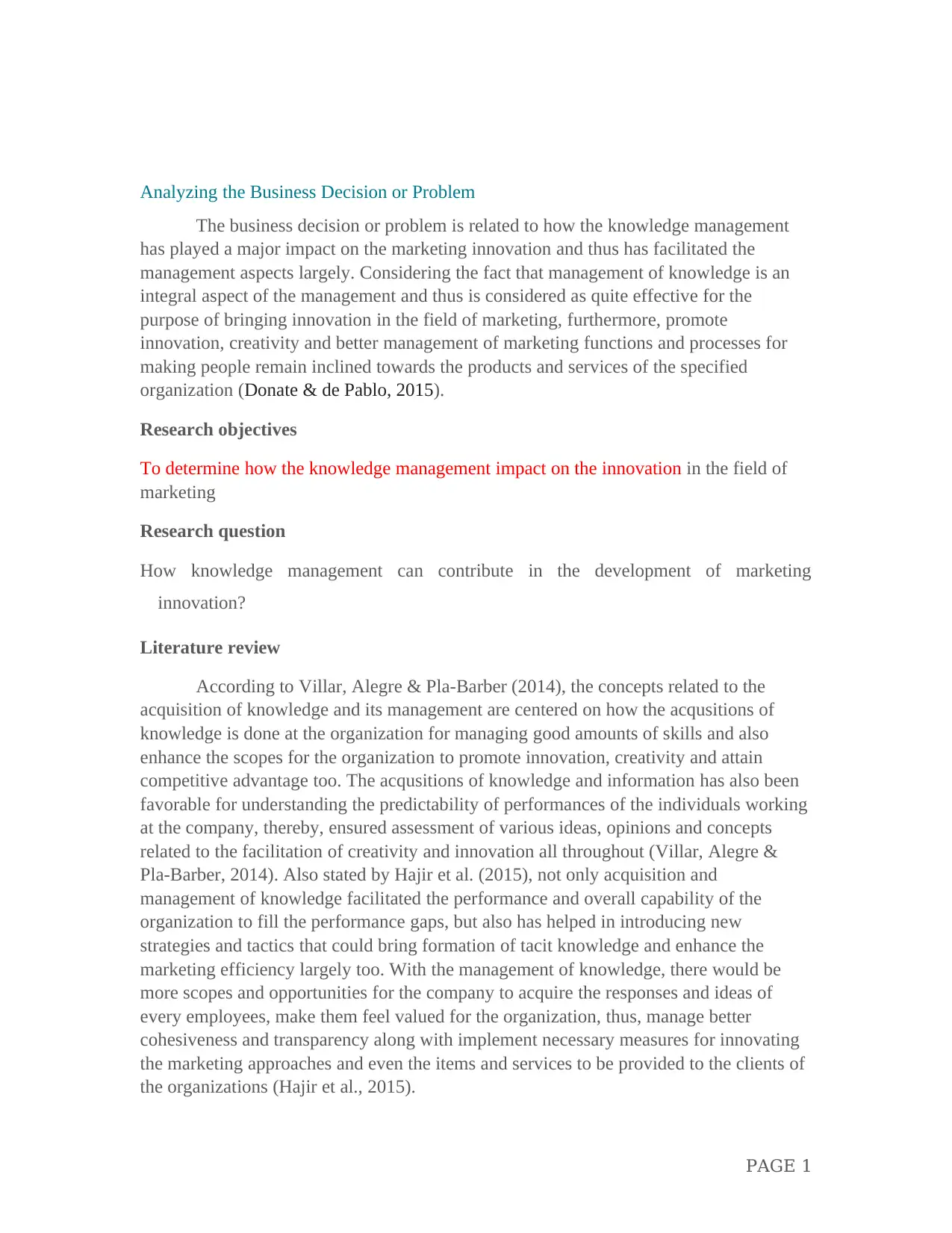
Analyzing the Business Decision or Problem
The business decision or problem is related to how the knowledge management
has played a major impact on the marketing innovation and thus has facilitated the
management aspects largely. Considering the fact that management of knowledge is an
integral aspect of the management and thus is considered as quite effective for the
purpose of bringing innovation in the field of marketing, furthermore, promote
innovation, creativity and better management of marketing functions and processes for
making people remain inclined towards the products and services of the specified
organization (Donate & de Pablo, 2015).
Research objectives
To determine how the knowledge management impact on the innovation in the field of
marketing
Research question
How knowledge management can contribute in the development of marketing
innovation?
Literature review
According to Villar, Alegre & Pla-Barber (2014), the concepts related to the
acquisition of knowledge and its management are centered on how the acqusitions of
knowledge is done at the organization for managing good amounts of skills and also
enhance the scopes for the organization to promote innovation, creativity and attain
competitive advantage too. The acqusitions of knowledge and information has also been
favorable for understanding the predictability of performances of the individuals working
at the company, thereby, ensured assessment of various ideas, opinions and concepts
related to the facilitation of creativity and innovation all throughout (Villar, Alegre &
Pla-Barber, 2014). Also stated by Hajir et al. (2015), not only acquisition and
management of knowledge facilitated the performance and overall capability of the
organization to fill the performance gaps, but also has helped in introducing new
strategies and tactics that could bring formation of tacit knowledge and enhance the
marketing efficiency largely too. With the management of knowledge, there would be
more scopes and opportunities for the company to acquire the responses and ideas of
every employees, make them feel valued for the organization, thus, manage better
cohesiveness and transparency along with implement necessary measures for innovating
the marketing approaches and even the items and services to be provided to the clients of
the organizations (Hajir et al., 2015).
PAGE 1
The business decision or problem is related to how the knowledge management
has played a major impact on the marketing innovation and thus has facilitated the
management aspects largely. Considering the fact that management of knowledge is an
integral aspect of the management and thus is considered as quite effective for the
purpose of bringing innovation in the field of marketing, furthermore, promote
innovation, creativity and better management of marketing functions and processes for
making people remain inclined towards the products and services of the specified
organization (Donate & de Pablo, 2015).
Research objectives
To determine how the knowledge management impact on the innovation in the field of
marketing
Research question
How knowledge management can contribute in the development of marketing
innovation?
Literature review
According to Villar, Alegre & Pla-Barber (2014), the concepts related to the
acquisition of knowledge and its management are centered on how the acqusitions of
knowledge is done at the organization for managing good amounts of skills and also
enhance the scopes for the organization to promote innovation, creativity and attain
competitive advantage too. The acqusitions of knowledge and information has also been
favorable for understanding the predictability of performances of the individuals working
at the company, thereby, ensured assessment of various ideas, opinions and concepts
related to the facilitation of creativity and innovation all throughout (Villar, Alegre &
Pla-Barber, 2014). Also stated by Hajir et al. (2015), not only acquisition and
management of knowledge facilitated the performance and overall capability of the
organization to fill the performance gaps, but also has helped in introducing new
strategies and tactics that could bring formation of tacit knowledge and enhance the
marketing efficiency largely too. With the management of knowledge, there would be
more scopes and opportunities for the company to acquire the responses and ideas of
every employees, make them feel valued for the organization, thus, manage better
cohesiveness and transparency along with implement necessary measures for innovating
the marketing approaches and even the items and services to be provided to the clients of
the organizations (Hajir et al., 2015).
PAGE 1

PAGE 2
⊘ This is a preview!⊘
Do you want full access?
Subscribe today to unlock all pages.

Trusted by 1+ million students worldwide
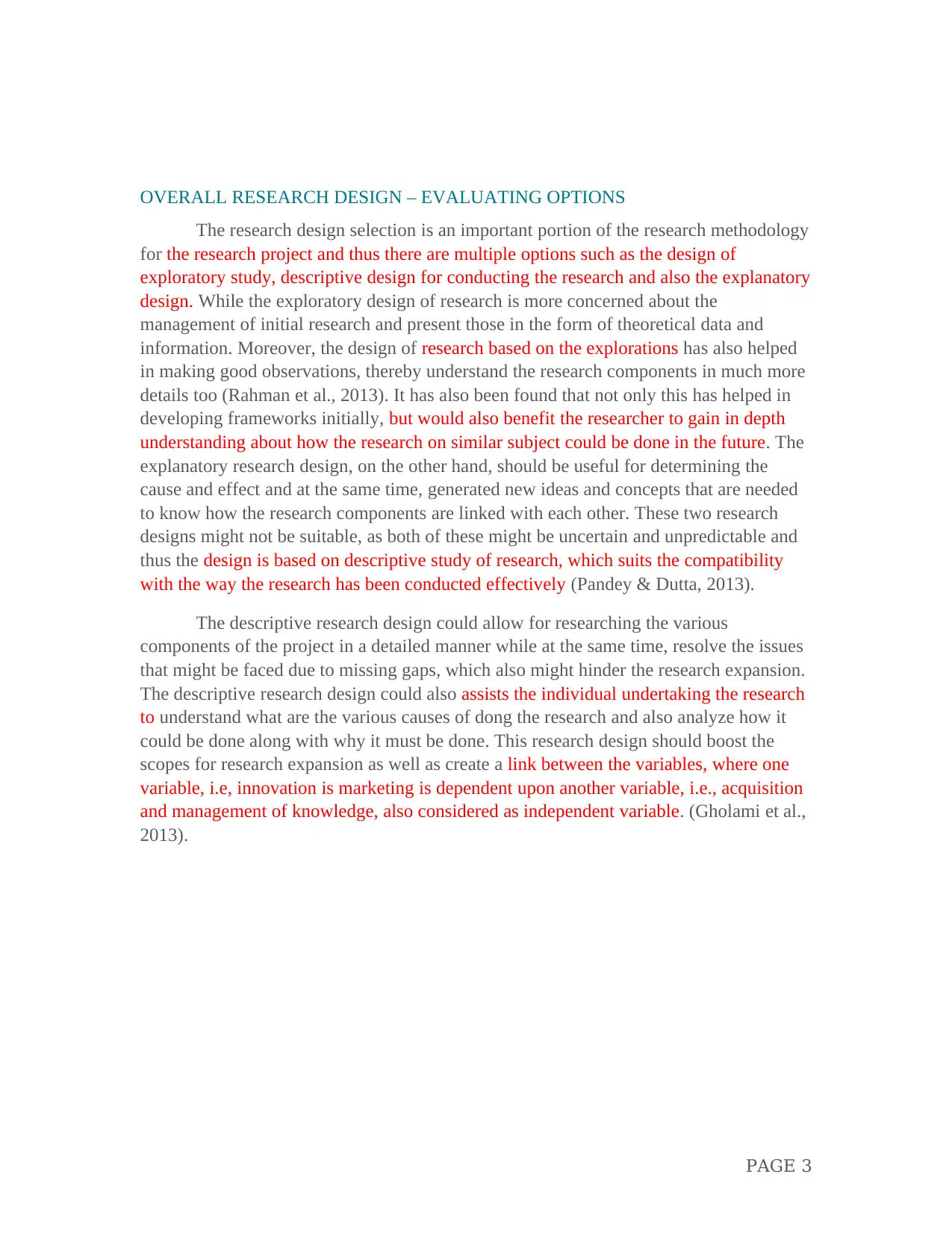
OVERALL RESEARCH DESIGN – EVALUATING OPTIONS
The research design selection is an important portion of the research methodology
for the research project and thus there are multiple options such as the design of
exploratory study, descriptive design for conducting the research and also the explanatory
design. While the exploratory design of research is more concerned about the
management of initial research and present those in the form of theoretical data and
information. Moreover, the design of research based on the explorations has also helped
in making good observations, thereby understand the research components in much more
details too (Rahman et al., 2013). It has also been found that not only this has helped in
developing frameworks initially, but would also benefit the researcher to gain in depth
understanding about how the research on similar subject could be done in the future. The
explanatory research design, on the other hand, should be useful for determining the
cause and effect and at the same time, generated new ideas and concepts that are needed
to know how the research components are linked with each other. These two research
designs might not be suitable, as both of these might be uncertain and unpredictable and
thus the design is based on descriptive study of research, which suits the compatibility
with the way the research has been conducted effectively (Pandey & Dutta, 2013).
The descriptive research design could allow for researching the various
components of the project in a detailed manner while at the same time, resolve the issues
that might be faced due to missing gaps, which also might hinder the research expansion.
The descriptive research design could also assists the individual undertaking the research
to understand what are the various causes of dong the research and also analyze how it
could be done along with why it must be done. This research design should boost the
scopes for research expansion as well as create a link between the variables, where one
variable, i.e, innovation is marketing is dependent upon another variable, i.e., acquisition
and management of knowledge, also considered as independent variable. (Gholami et al.,
2013).
PAGE 3
The research design selection is an important portion of the research methodology
for the research project and thus there are multiple options such as the design of
exploratory study, descriptive design for conducting the research and also the explanatory
design. While the exploratory design of research is more concerned about the
management of initial research and present those in the form of theoretical data and
information. Moreover, the design of research based on the explorations has also helped
in making good observations, thereby understand the research components in much more
details too (Rahman et al., 2013). It has also been found that not only this has helped in
developing frameworks initially, but would also benefit the researcher to gain in depth
understanding about how the research on similar subject could be done in the future. The
explanatory research design, on the other hand, should be useful for determining the
cause and effect and at the same time, generated new ideas and concepts that are needed
to know how the research components are linked with each other. These two research
designs might not be suitable, as both of these might be uncertain and unpredictable and
thus the design is based on descriptive study of research, which suits the compatibility
with the way the research has been conducted effectively (Pandey & Dutta, 2013).
The descriptive research design could allow for researching the various
components of the project in a detailed manner while at the same time, resolve the issues
that might be faced due to missing gaps, which also might hinder the research expansion.
The descriptive research design could also assists the individual undertaking the research
to understand what are the various causes of dong the research and also analyze how it
could be done along with why it must be done. This research design should boost the
scopes for research expansion as well as create a link between the variables, where one
variable, i.e, innovation is marketing is dependent upon another variable, i.e., acquisition
and management of knowledge, also considered as independent variable. (Gholami et al.,
2013).
PAGE 3
Paraphrase This Document
Need a fresh take? Get an instant paraphrase of this document with our AI Paraphraser
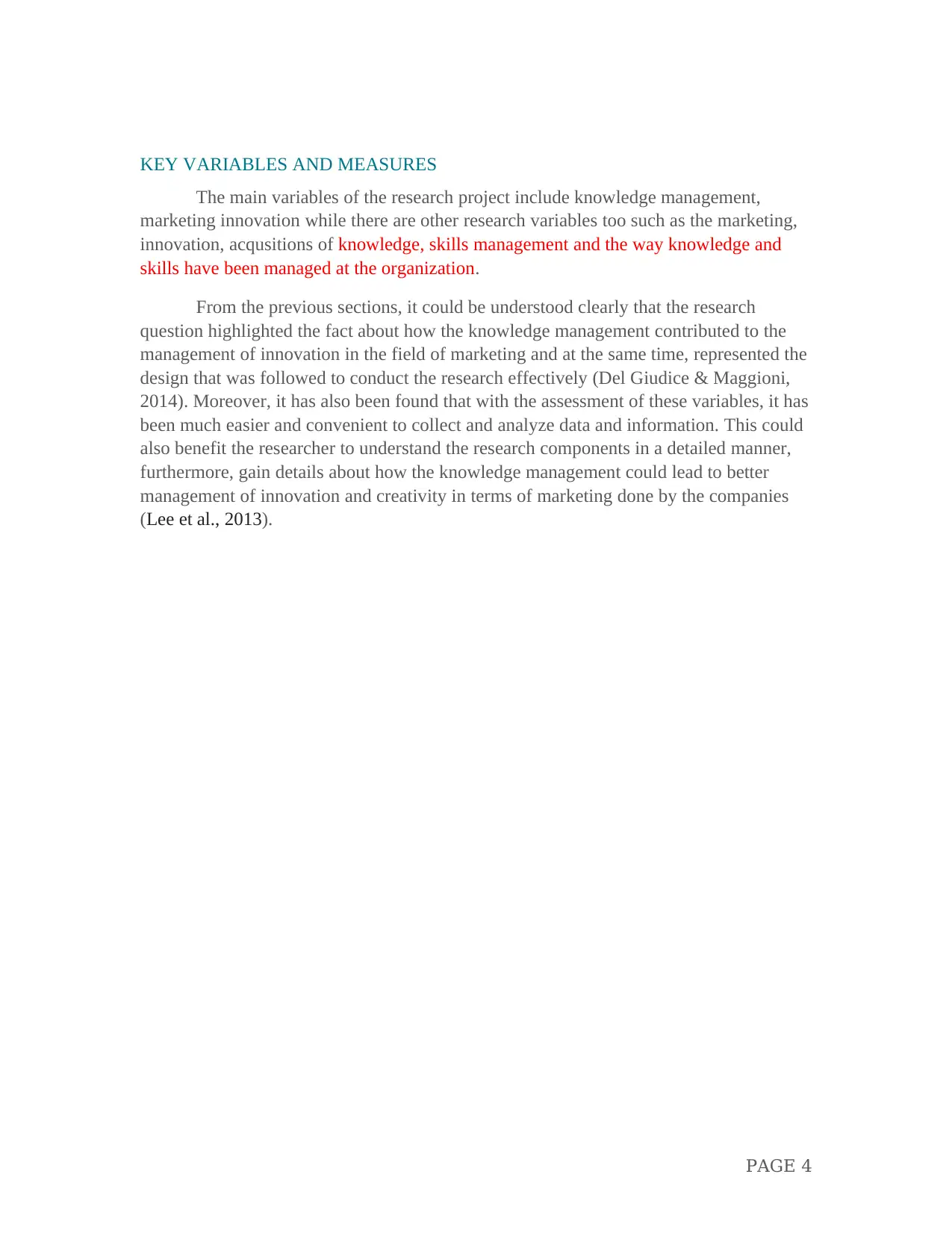
KEY VARIABLES AND MEASURES
The main variables of the research project include knowledge management,
marketing innovation while there are other research variables too such as the marketing,
innovation, acqusitions of knowledge, skills management and the way knowledge and
skills have been managed at the organization.
From the previous sections, it could be understood clearly that the research
question highlighted the fact about how the knowledge management contributed to the
management of innovation in the field of marketing and at the same time, represented the
design that was followed to conduct the research effectively (Del Giudice & Maggioni,
2014). Moreover, it has also been found that with the assessment of these variables, it has
been much easier and convenient to collect and analyze data and information. This could
also benefit the researcher to understand the research components in a detailed manner,
furthermore, gain details about how the knowledge management could lead to better
management of innovation and creativity in terms of marketing done by the companies
(Lee et al., 2013).
PAGE 4
The main variables of the research project include knowledge management,
marketing innovation while there are other research variables too such as the marketing,
innovation, acqusitions of knowledge, skills management and the way knowledge and
skills have been managed at the organization.
From the previous sections, it could be understood clearly that the research
question highlighted the fact about how the knowledge management contributed to the
management of innovation in the field of marketing and at the same time, represented the
design that was followed to conduct the research effectively (Del Giudice & Maggioni,
2014). Moreover, it has also been found that with the assessment of these variables, it has
been much easier and convenient to collect and analyze data and information. This could
also benefit the researcher to understand the research components in a detailed manner,
furthermore, gain details about how the knowledge management could lead to better
management of innovation and creativity in terms of marketing done by the companies
(Lee et al., 2013).
PAGE 4
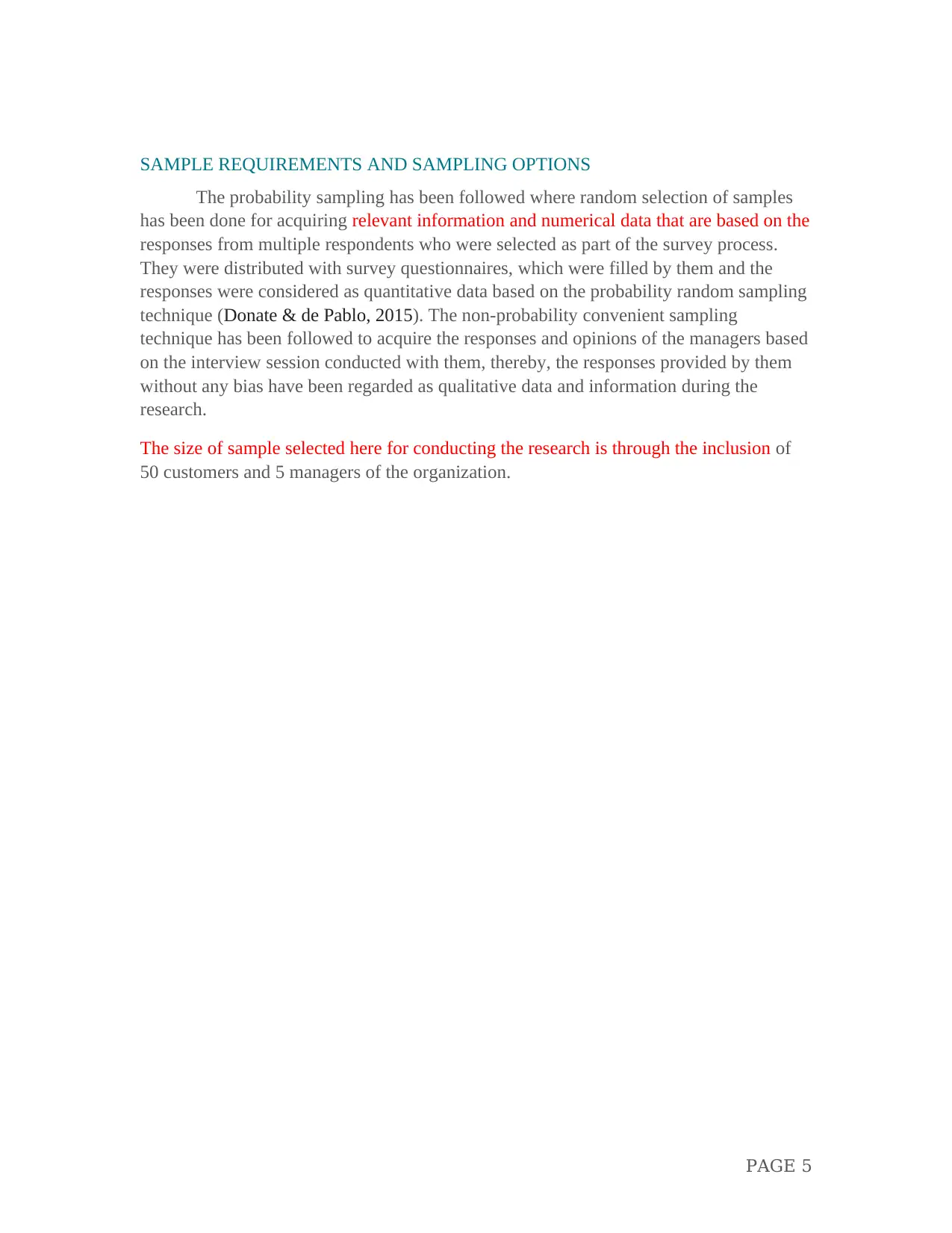
SAMPLE REQUIREMENTS AND SAMPLING OPTIONS
The probability sampling has been followed where random selection of samples
has been done for acquiring relevant information and numerical data that are based on the
responses from multiple respondents who were selected as part of the survey process.
They were distributed with survey questionnaires, which were filled by them and the
responses were considered as quantitative data based on the probability random sampling
technique (Donate & de Pablo, 2015). The non-probability convenient sampling
technique has been followed to acquire the responses and opinions of the managers based
on the interview session conducted with them, thereby, the responses provided by them
without any bias have been regarded as qualitative data and information during the
research.
The size of sample selected here for conducting the research is through the inclusion of
50 customers and 5 managers of the organization.
PAGE 5
The probability sampling has been followed where random selection of samples
has been done for acquiring relevant information and numerical data that are based on the
responses from multiple respondents who were selected as part of the survey process.
They were distributed with survey questionnaires, which were filled by them and the
responses were considered as quantitative data based on the probability random sampling
technique (Donate & de Pablo, 2015). The non-probability convenient sampling
technique has been followed to acquire the responses and opinions of the managers based
on the interview session conducted with them, thereby, the responses provided by them
without any bias have been regarded as qualitative data and information during the
research.
The size of sample selected here for conducting the research is through the inclusion of
50 customers and 5 managers of the organization.
PAGE 5
⊘ This is a preview!⊘
Do you want full access?
Subscribe today to unlock all pages.

Trusted by 1+ million students worldwide
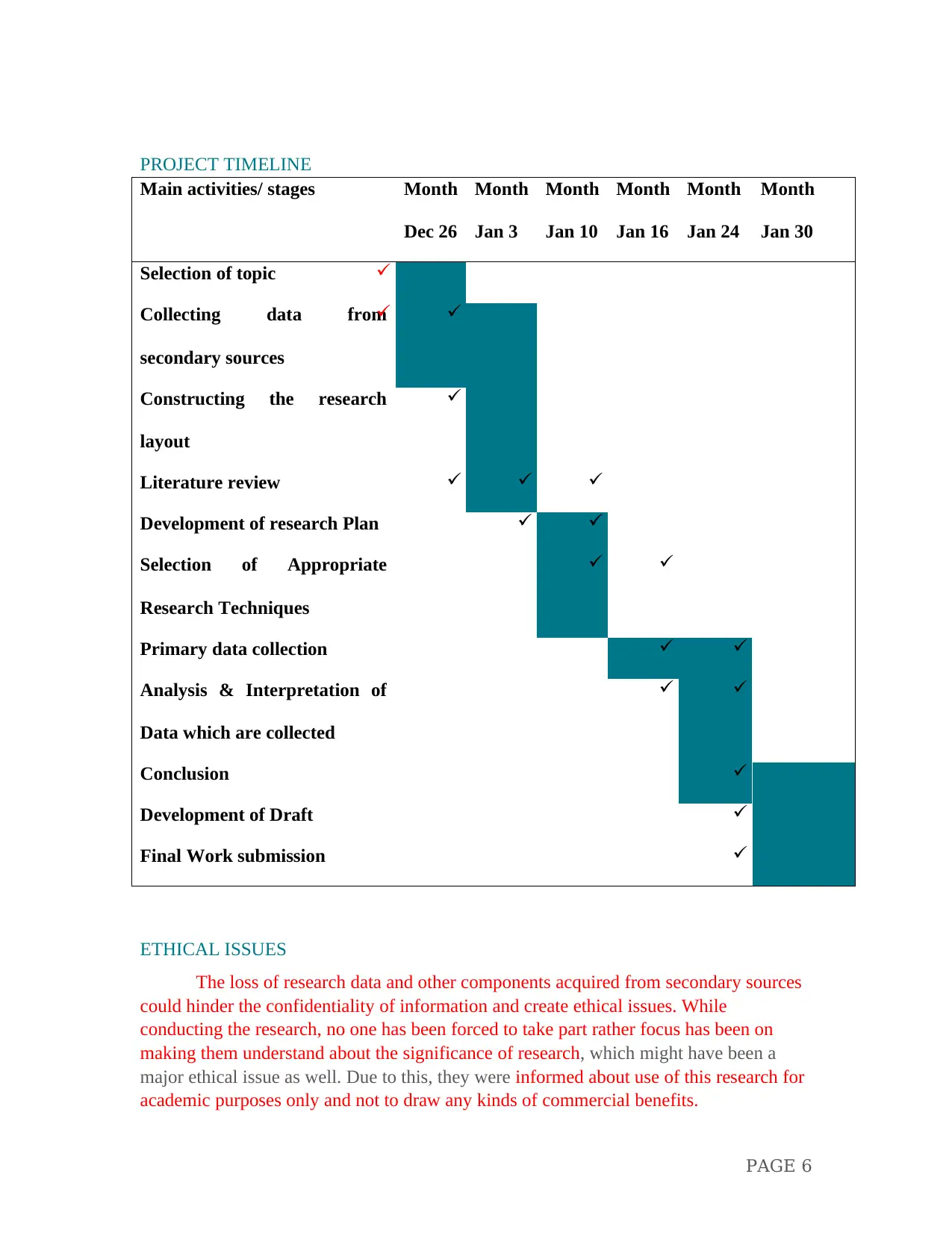
PROJECT TIMELINE
Main activities/ stages Month
Dec 26
Month
Jan 3
Month
Jan 10
Month
Jan 16
Month
Jan 24
Month
Jan 30
Selection of topic
Collecting data from
secondary sources
Constructing the research
layout
Literature review
Development of research Plan
Selection of Appropriate
Research Techniques
Primary data collection
Analysis & Interpretation of
Data which are collected
Conclusion
Development of Draft
Final Work submission
ETHICAL ISSUES
The loss of research data and other components acquired from secondary sources
could hinder the confidentiality of information and create ethical issues. While
conducting the research, no one has been forced to take part rather focus has been on
making them understand about the significance of research, which might have been a
major ethical issue as well. Due to this, they were informed about use of this research for
academic purposes only and not to draw any kinds of commercial benefits.
PAGE 6
Main activities/ stages Month
Dec 26
Month
Jan 3
Month
Jan 10
Month
Jan 16
Month
Jan 24
Month
Jan 30
Selection of topic
Collecting data from
secondary sources
Constructing the research
layout
Literature review
Development of research Plan
Selection of Appropriate
Research Techniques
Primary data collection
Analysis & Interpretation of
Data which are collected
Conclusion
Development of Draft
Final Work submission
ETHICAL ISSUES
The loss of research data and other components acquired from secondary sources
could hinder the confidentiality of information and create ethical issues. While
conducting the research, no one has been forced to take part rather focus has been on
making them understand about the significance of research, which might have been a
major ethical issue as well. Due to this, they were informed about use of this research for
academic purposes only and not to draw any kinds of commercial benefits.
PAGE 6
Paraphrase This Document
Need a fresh take? Get an instant paraphrase of this document with our AI Paraphraser

PAGE 7
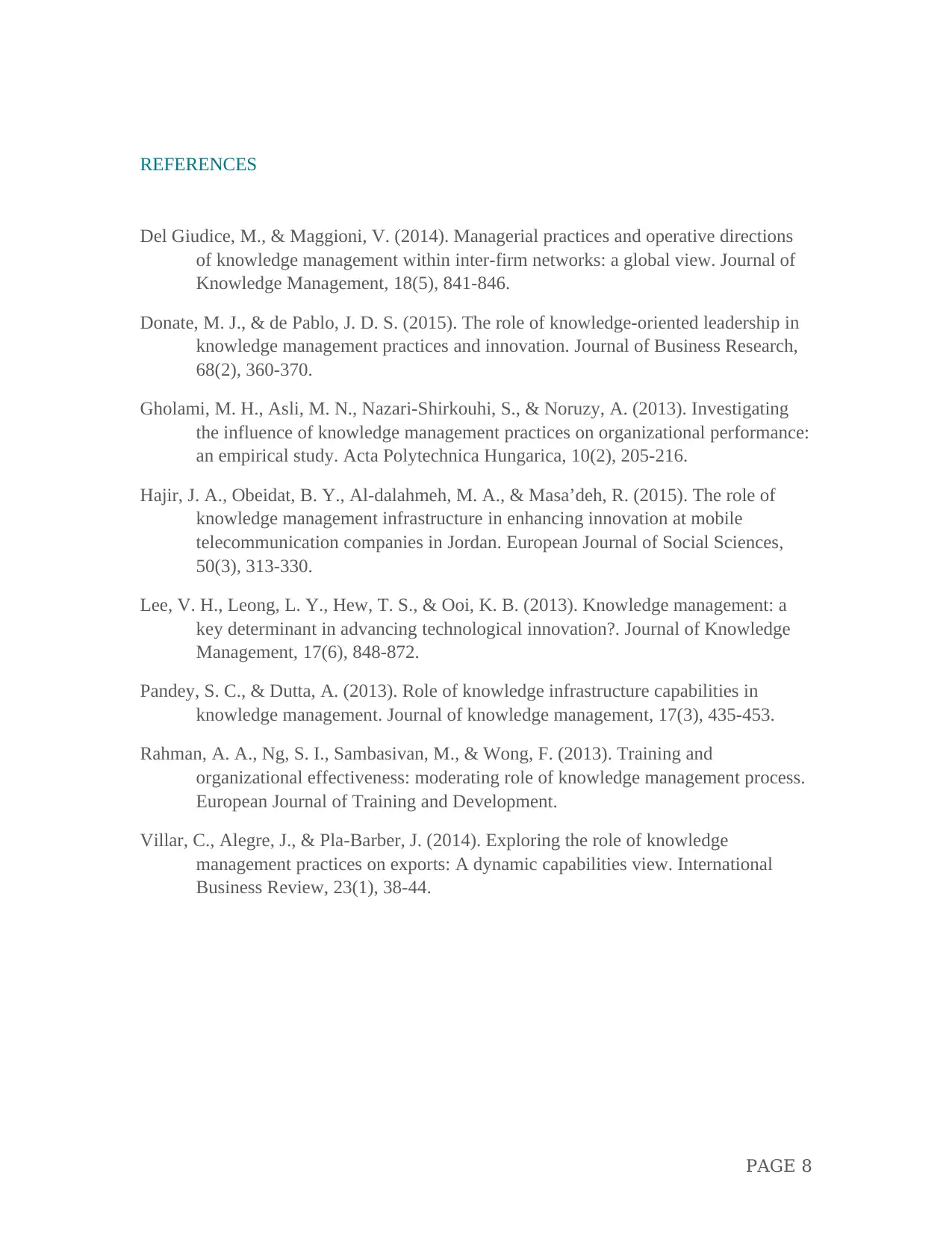
REFERENCES
Del Giudice, M., & Maggioni, V. (2014). Managerial practices and operative directions
of knowledge management within inter-firm networks: a global view. Journal of
Knowledge Management, 18(5), 841-846.
Donate, M. J., & de Pablo, J. D. S. (2015). The role of knowledge-oriented leadership in
knowledge management practices and innovation. Journal of Business Research,
68(2), 360-370.
Gholami, M. H., Asli, M. N., Nazari-Shirkouhi, S., & Noruzy, A. (2013). Investigating
the influence of knowledge management practices on organizational performance:
an empirical study. Acta Polytechnica Hungarica, 10(2), 205-216.
Hajir, J. A., Obeidat, B. Y., Al-dalahmeh, M. A., & Masa’deh, R. (2015). The role of
knowledge management infrastructure in enhancing innovation at mobile
telecommunication companies in Jordan. European Journal of Social Sciences,
50(3), 313-330.
Lee, V. H., Leong, L. Y., Hew, T. S., & Ooi, K. B. (2013). Knowledge management: a
key determinant in advancing technological innovation?. Journal of Knowledge
Management, 17(6), 848-872.
Pandey, S. C., & Dutta, A. (2013). Role of knowledge infrastructure capabilities in
knowledge management. Journal of knowledge management, 17(3), 435-453.
Rahman, A. A., Ng, S. I., Sambasivan, M., & Wong, F. (2013). Training and
organizational effectiveness: moderating role of knowledge management process.
European Journal of Training and Development.
Villar, C., Alegre, J., & Pla-Barber, J. (2014). Exploring the role of knowledge
management practices on exports: A dynamic capabilities view. International
Business Review, 23(1), 38-44.
PAGE 8
Del Giudice, M., & Maggioni, V. (2014). Managerial practices and operative directions
of knowledge management within inter-firm networks: a global view. Journal of
Knowledge Management, 18(5), 841-846.
Donate, M. J., & de Pablo, J. D. S. (2015). The role of knowledge-oriented leadership in
knowledge management practices and innovation. Journal of Business Research,
68(2), 360-370.
Gholami, M. H., Asli, M. N., Nazari-Shirkouhi, S., & Noruzy, A. (2013). Investigating
the influence of knowledge management practices on organizational performance:
an empirical study. Acta Polytechnica Hungarica, 10(2), 205-216.
Hajir, J. A., Obeidat, B. Y., Al-dalahmeh, M. A., & Masa’deh, R. (2015). The role of
knowledge management infrastructure in enhancing innovation at mobile
telecommunication companies in Jordan. European Journal of Social Sciences,
50(3), 313-330.
Lee, V. H., Leong, L. Y., Hew, T. S., & Ooi, K. B. (2013). Knowledge management: a
key determinant in advancing technological innovation?. Journal of Knowledge
Management, 17(6), 848-872.
Pandey, S. C., & Dutta, A. (2013). Role of knowledge infrastructure capabilities in
knowledge management. Journal of knowledge management, 17(3), 435-453.
Rahman, A. A., Ng, S. I., Sambasivan, M., & Wong, F. (2013). Training and
organizational effectiveness: moderating role of knowledge management process.
European Journal of Training and Development.
Villar, C., Alegre, J., & Pla-Barber, J. (2014). Exploring the role of knowledge
management practices on exports: A dynamic capabilities view. International
Business Review, 23(1), 38-44.
PAGE 8
⊘ This is a preview!⊘
Do you want full access?
Subscribe today to unlock all pages.

Trusted by 1+ million students worldwide
1 out of 9
Related Documents
Your All-in-One AI-Powered Toolkit for Academic Success.
+13062052269
info@desklib.com
Available 24*7 on WhatsApp / Email
![[object Object]](/_next/static/media/star-bottom.7253800d.svg)
Unlock your academic potential
Copyright © 2020–2025 A2Z Services. All Rights Reserved. Developed and managed by ZUCOL.




